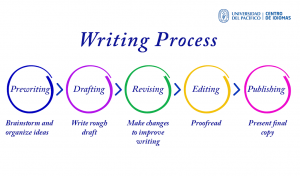The idea in this particular series of articles is to deal with those things that are necessary for students to know but, for a variety of reasons (call them school programs, syllabus, time constraints or whatever) teachers neglect to address. The conundrum is that this article deals with teaching writing and the author believes that we language instructors really do not teach our students how to write. That makes it an arduous task to pinpoint what is not being imparted.
For the wide majority of the textbooks our students use their approach to teaching writing consists on presenting a model of a piece of writing, for instance an email. Then they try to familiarize the students with its parts, strategy, register and wording, perhaps teach some useful vocabulary and then ask the students to produce something similar.
This helps the learners become familiar with different formats and types of communication but it is a long way away from teaching them how to put the words together to communicate, to transmit, to inform, to instruct, to provoke, to excite, to convince, etc., in a meaningful, pleasing or unpleasing, emphatic, authoritative, suggestive or any other way.
The classical strategy to give students a topic and tell them to write about it does not do it even if we carefully correct their mistakes. It is necessary to show them the route and not just redirect them when they go astray.
Fortunately there are some educators who teach writing as a process, and this is much more useful. It involves pre-writing, drafting, revising, rewriting, evaluating or proofreading and publishing. They are going in the right direction.
You have to keep in mind that you are never going to write acceptably without an appropriate knowledge of grammar, so the instruction of it should go in parallel. Then an able handling of collocations is a must together with familiarity and dexterity in the use of discourse markers, transitions, connectors and the like.
Another point that is absolutely basic but we usually take for granted is punctuation. The result is that a very large number of learners ignore how to use those ‘strange symbols.’
The Spanish syntax possesses extraordinary flexibility. You can vary the order of the sentence elements in a countless number of ways. When Spanish speakers speak or especially write in English try to exercise the same capacity but the possibilities are much more restricted. We must teach them to widely use the subject / verb /complement structure and leave for later the specific occasions in which we are allowed to subvert that sequence.
And these things are just the most basic bits of wisdom we should give our students on the matter. From then we should move on to things that are still fundamental but that hardly anybody teaches like topic sentences, thesis statements the three or the five paragraphs compositions, the cyclical structure in which the conclusion reinforces the introduction, paraphrasing and many other important things, that the limitation of space forestalls further expansion.
Now is your turn:
Ask the question to yourself and respond sincerely: Do I really teach my students how to write?
Estimated reading time: 2 minutes, 36 seconds












Are you struggling with teaching writing? In this post, some important guidelines to enhance this skill.
Comments are closed.